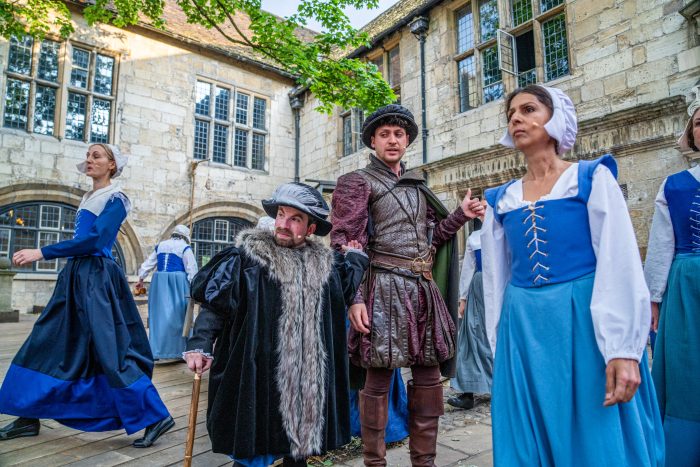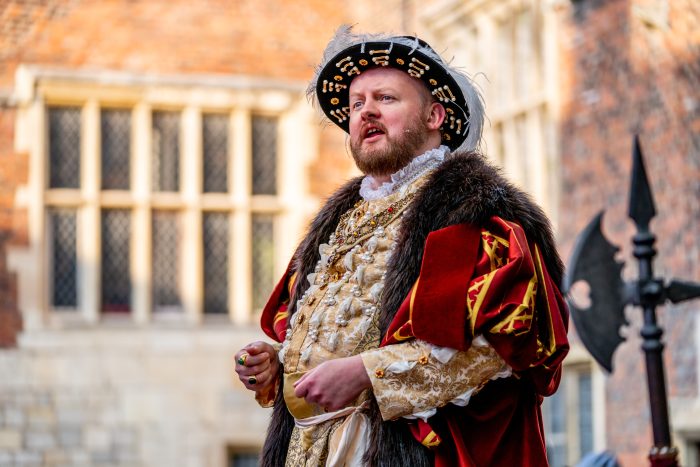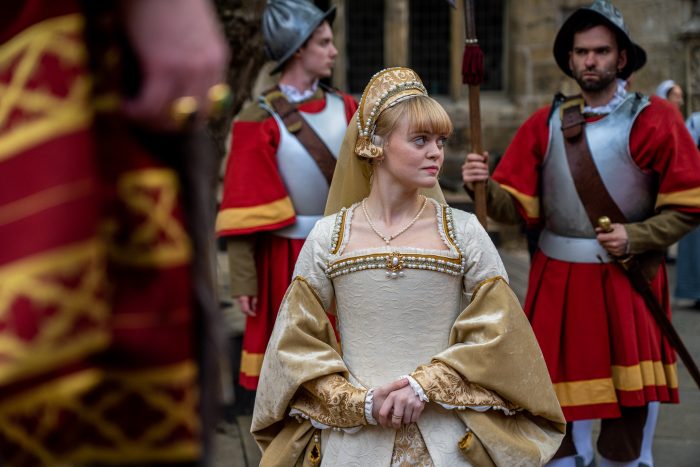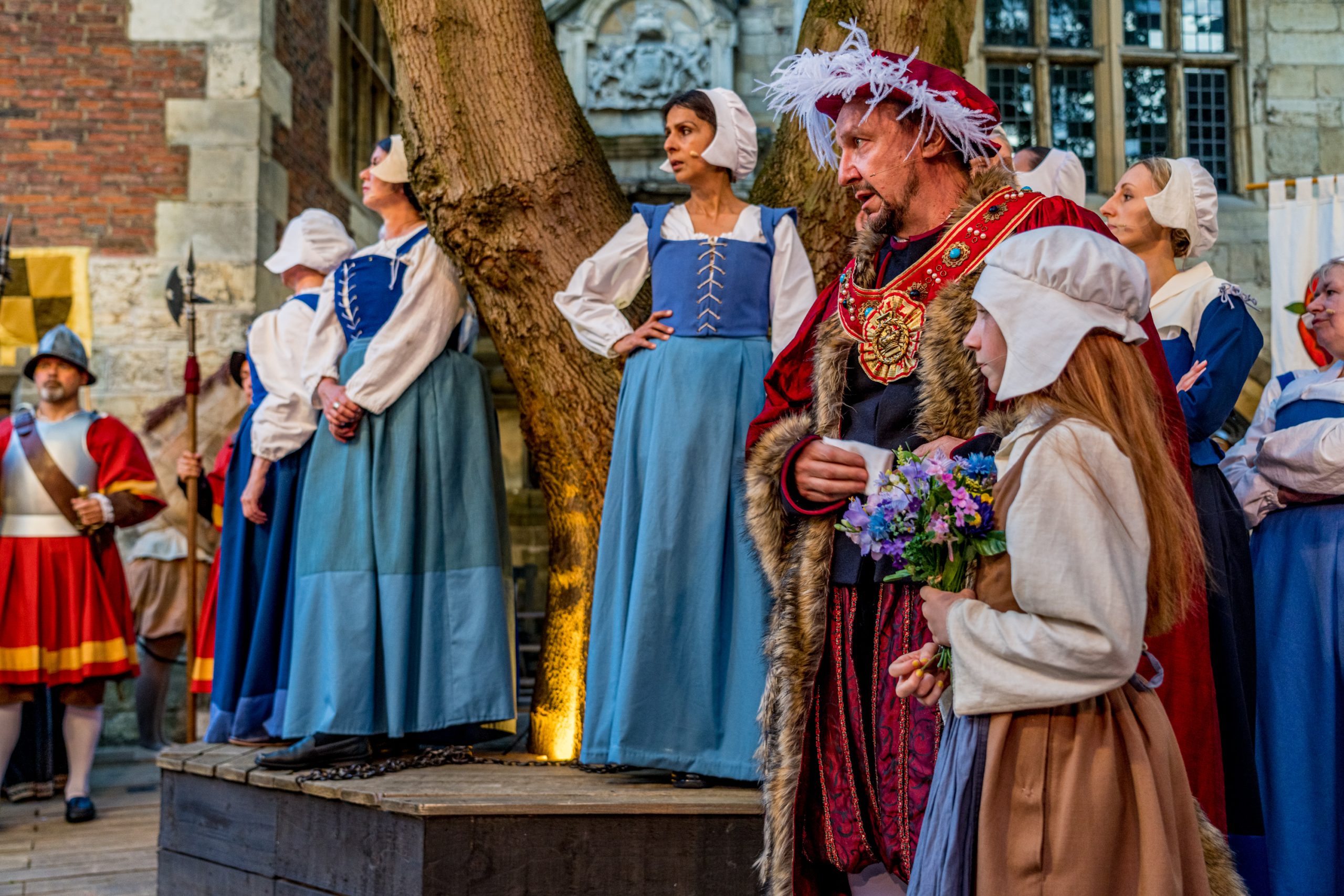The University of York’s King’s Manor. A favourite studying hub for students who want a bit of dark- academia-core and atmosphere whilst in town. Leased to the University from the York City Council since 1963, King’s Manor has a long history. Having famously hosted King Henry VIII on a Royal Progress of the North in 1541 (hence the name), it was converted from the Abbot’s House of the dissolved St. Mary’s Monastery (the remains of which are in today’s Museum Gardens).
This visit of England’s most infamous King forms the background of the play Sovereign, an adaption of the C.J. Sansom book by Mike Kenny. York Theatre Royal utterly transformed the courtyard of King’s Manor into a vast and immersive performing space to put on this play. Vision’s Jacob Bassford and Suzannah Binns went to the Wednesday 19th evening performance.
The play follows the fictional King’s Lawyer, Matthew Shardlake (played by professional actor Fergus Rattigan), who is visiting York ahead of the Royal Progress on secret business of his superior, the Archbishop of Canterbury Thomas Cranmer, accompanied by his loud-mouth assistant, Jack Barak (played by Sam Thorpe-Sprinks, not only also a professional actor but also a University of York graduate). However this task soon turns into a murder mystery that involves a conspiracy to depose the King because of a secret about his royal lineage and the Tudor claim to the throne in a city that has not forgotten the Dissolution of the Monasteries and the Pilgrimage of Grace.

The play is narrated by a group of York guildswomen performing what is called a Mystery Cycle. This was a centuries-long tradition of community play-performing in York that was put to an end by Henry VIII in his attempts to end Catholicism in the North. This directing choice was deeply powerful for many reasons, mainly for giving those a voice in history that had been silenced by powerful men such Henry VIII. This chorus of guildswomen were all played by locals, the women of York today portraying the women of York in 1541, a powerful cultural homage.
The Chorus actors did not let a few mic issues hinder their dominance on the stage. Co-Directors Juliet Forster, Mingyu Lin and John R. Wilkinson utilised the chorus to full affect, they were not just narrators but also active participants in the events of play, and they also shielded the audience from certain points in the play, performing the role of blackouts and curtains, allowing for mostly effective scene transitions in the outdoor setting of King’s Manor Courtyard.
Their narration kept the audience grounded in both historical context and the wider events of the play that could not be performed outright and kept the pace of the play flowing, which was commendably effective given the scale and scope of the story.

“The chorus was really effective was explaining the context, this made the play more accessible; it meant you didn’t have to be an avid historian (like us) or a local, to appreciate the setting of the play.”
Another way in which the chorus was really effective was explaining the context, this made the play more accessible; it meant you didn’t have to be an avid historian (like us) or a local, to appreciate the setting of the play.
Context covered a wide array of history, from the massacre of Jews at Clifford’s Tower in 1190, to the Wars of the Roses, the dissolution of the Monasteries and the Pilgrimage of Grace the rebellion of the North in response to religious change in which York was heavily punished in 1536, five years before the events of the play. Thus, the tumultuous background of the play was conveyed really well, and that added significantly to how the plot was portrayed.
The scale of the entire production was really impressive. This was not just just a reflection of the size of the cast, but gave the audience an insight into the preparations and pomp of the Royal Progress itself that did actually take place in 1541.
The scale is not only to be seen on the stage but also off it. This is demonstrated in the credited costume list with a whopping 75 people involved in the costume making process, and the whole 100+ cast looked incredible and aesthetically accurate!
The background of King’s Manor and the quality of costumes complemented the minimalist use of props on stage which was a nice of contrast that meant the audience didn’t get lost from the events of the plot, Brecht would approve. In fact, it is difficult to credibly critique all aspects of the play given the sheer number of people on stage and the size of the production.
However, what was perhaps most impressive about the scale of the production was that we as the audience never felt lost in the detail of the plot and the size of the cast, and that is a considerable achievement by the cast and the production team.

Accompanying both the scene transitions and dramatic moments of the play was the 63-strong choir, this gave scenes even more atmosphere and added to the moments of tension but also the scenes of joviality, where the entire cast was on stage doing a Tudor-era dance to welcome Henry VIII (played by Mark Gowland) to the city. This atmosphere was more grounded with the choir being there in the flesh performing in real-time, and was another effective way in which the audience felt transported to King’s Manor in 1541.
Outside of Rattigan and Thorpe-Spinks, the entire cast was made up of local community actors (including University students). The cast worked well together, resulting in a seamless narrative flow which was necessary for a production of this scale to be accessible for audiences and the acting was strong by all involved.
Whilst the use of the Chorus was an effective multifaceted device, it did mean that we lost a bit of variety to the main character of Shardlake. In the books by C.J. Sansom (a very good read by the way, would recommend), Shardlake is a third-person narrator, and although it was clear in the play that he was the main actor, it was difficult at times to see thoughts and motivations that would appear in the book.
This is a challenge of adapting a book to a play, but we did feel that by using the Chorus as a narrative device meant we lost a bit of depth to the character of Shardlake, this is despite an otherwise compelling performance by Fergus Rattigan. There were points were the Chorus was able to convey the inner dialogue of Shardlake or the character’s motivations (especially at the ending), but unfortunately not enough in our opinion.
“The choice of using King’s Manor to perform this play was more than just historical accuracy and being aesthetic. It reinforces the continuing legacy of the past on the present…”
Ultimately, the choice of using King’s Manor to perform this play was more than just historical accuracy and being aesthetic. It reinforces the continuing legacy of the past on the present and it laid bare the main themes interwoven throughout the play: themes of discrimination, power, religious turmoil, intolerance, misogyny, poverty and oppression.
The impressive direction of the play and the performances meant these themes were powerfully broadcasted, rather than lost in the epic grandeur and scale of the production. The chorus’s concluding statement about history being written by male victors presents these as themes that resonate today as powerfully as they did over half a millennium ago in 1541.
Sovereign is being performed again at King’s Manor with matinee and evening performances on Saturday 22nd and Sunday 23rd of July. Tickets are available here from the York Theatre Royal website.
